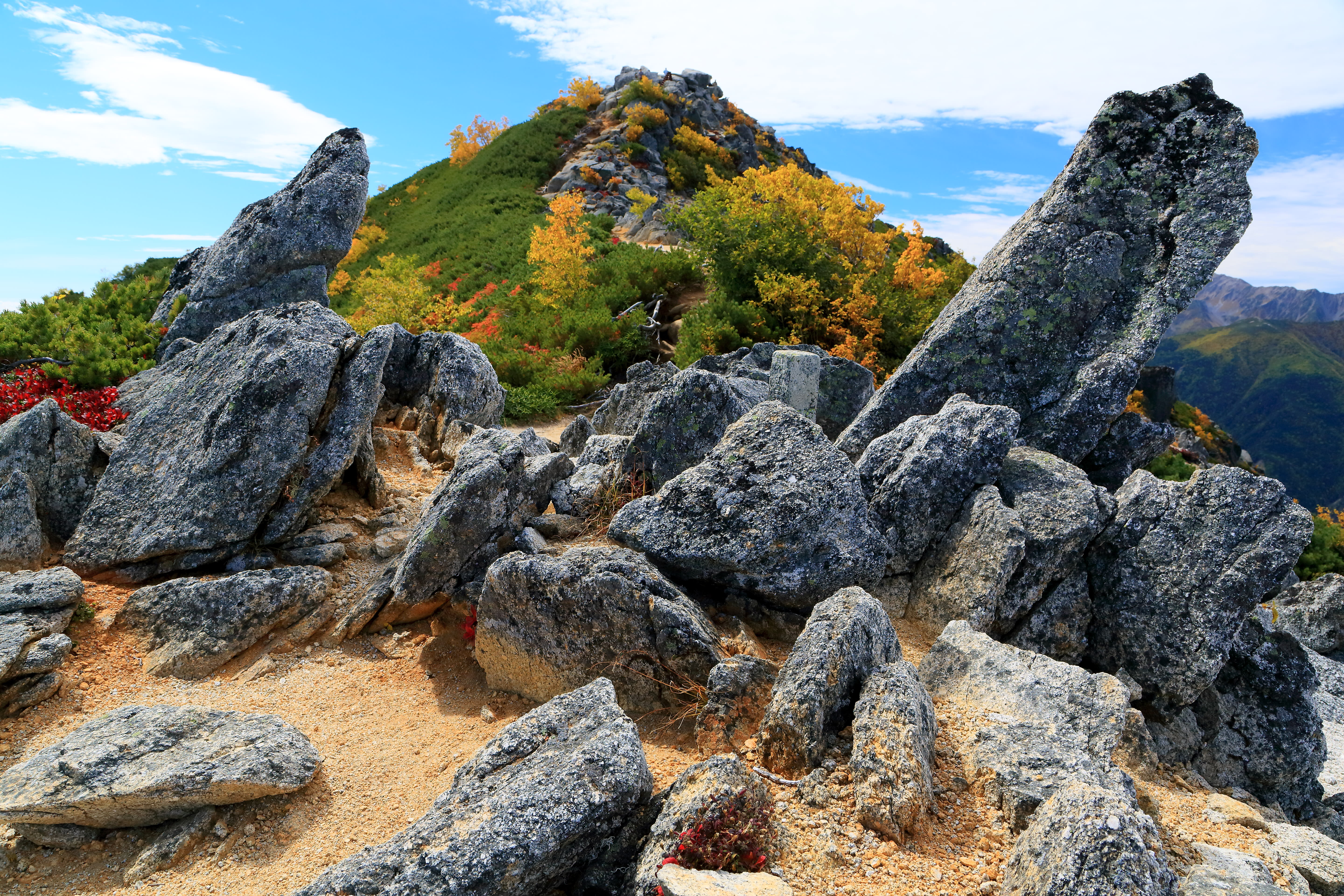
Rocky outcrops along the trails in Minami Alps National Park
Japan's fall foliage
Leaves begin to change color in early September in the mountains of Hokkaido, Japan’s northernmost island, and the fall color front gradually moves south through September, October and November. Visitors to Japan’s national parks have around a three-month window to enjoy mountains and marshlands covered in colorful tapestries as the leaves change over multiple elevations.
The iconic Japanese maple (momiji) steals the show in many parts of the country, with leaves changing from soft green to deep red, yellow and even purple. Katsura (Cercidiphyllum japonicum) grows throughout Japan’s northern forests, with lovely heart-shaped leaves that turn shades of yellow and orange in autumn. As their leaves fall, katsura trees emit a sweet fragrance, similar to caramel or brown sugar. Japanese beech trees, also known as Siebold’s beech, are widespread throughout Japan and turn shades of amber and brown, which contrast beautifully with the tree’s smooth, grey bark.

Japanese larch trees and the Japanese Alps in Chubusangaku National Park
The deciduous Japanese larch, whose needles turn a striking golden yellow, is one of the few conifers that change colors and lose their needles in autumn. You can see groves of Japanese larch in various alpine areas up to 2,900 meters. The hiking trails around Kamikochi in Chubusangaku National Park are a noteworthy spot to see them.
Another high-altitude plant that changes color in autumn is the Japanese rowan (nanakamado), a small mountain ash native to Japan. You can see their blazing red leaves above the treeline on many of Japan’s mountains in autumn, sometimes covering the entire mountainside. Daisetsuzan National Park is one good place to spot them, on the slopes of Mount Asahidake and Mount Kurodake.
Golden grasses

Ayamedaira Marsh's grasses turn a fiery red in Oze National Park
Grasses that change color add to autumn's warm palette, and are known as kusamomiji in Japan. Ozegahara Marsh in Oze National Park and Senjogahara in Nikko National Park are excellent areas to see bright red and orange autumnal grasses spread across the wetlands. Visit Tadewara Marsh in Aso-Kuju National Park to see the marshland transformed into a delicate golden brown, with the surrounding mountains dappled with shades of red and yellow. September to October is usually a good time to visit these areas.
Hike amid colorful leaves
Hiking is one of the best ways to enjoy the autumn season, and Japan’s national parks have hundreds of hiking and walking trails to choose from. The mountains are crisscrossed with well-maintained networks of trails, with mountain huts and places to camp if you want to extend your stay in the mountains. Be sure to check the weather forecast in advance and bring adequate warm clothing for chilly nights. Snow begins to fall on Japan’s tallest peaks from late September.
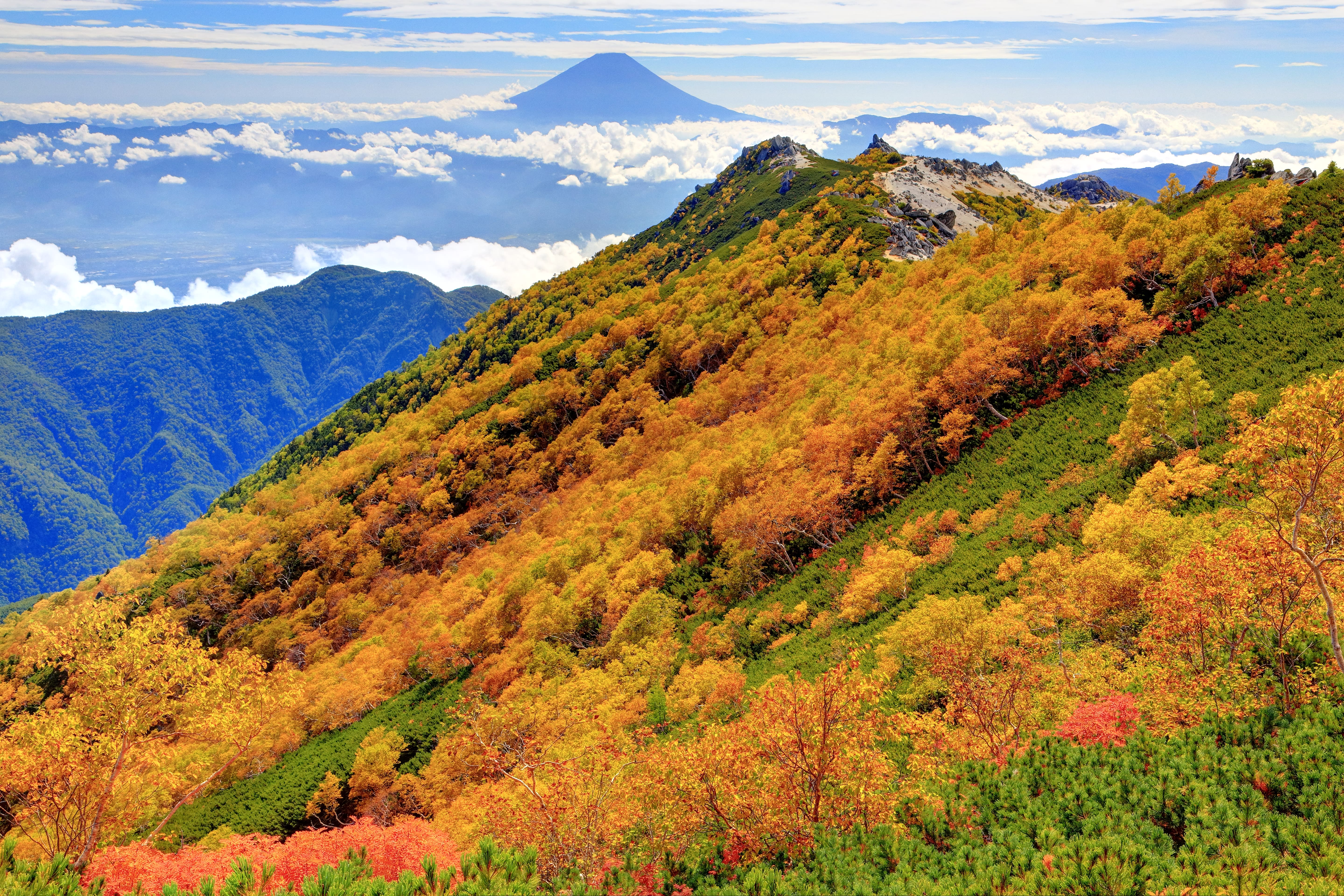
Views of Mount Fuji from Mount Yakushi in Minami Alps National Park
Enthusiastic hikers can take on the challenging climbing trails of the Japanese Alps, which boast several peaks over 3,000 meters. Minami Alps National Park, which straddles Yamanashi, Shizuoka and Nagano prefectures, is known for Mount Kitadake (3,193 m), Japan’s second-highest peak after Mount Fuji. The mountain ranges here have spectacular amphitheater-like valleys and dramatic rocky outcrops, which become even more awe-inspiring against the backdrop of vibrant autumn leaves.
You can find plenty of moderate hiking trails across all of Japan’s national parks, from the gentle Oirase Trail along Oirase Stream in Towada-Hachimantai National Park to Nikko National Park’s Shin-Kashi Nature Trail,, and the numerous trails throughout Chichibu-Tama-Kai National Park near Tokyo. In southern Japan, several hiking trails through the Ebino Highlands in Kirishima-Kinkowan National Park feature crater lakes that beautifully reflect the colorful autumn foliage.
Ride ropeways above fall foliage
For those who would like to enjoy leaf-peeping at a more leisurely pace, ropeways are an easy way to access Japan’s mountain foliage without the hike. The term “ropeway” in Japan encompasses various forms of aerial lift, including gondolas and aerial tramways. Many of Japan’s ropeways are part of ski resorts, whisking passengers up to above 2,000 meters.
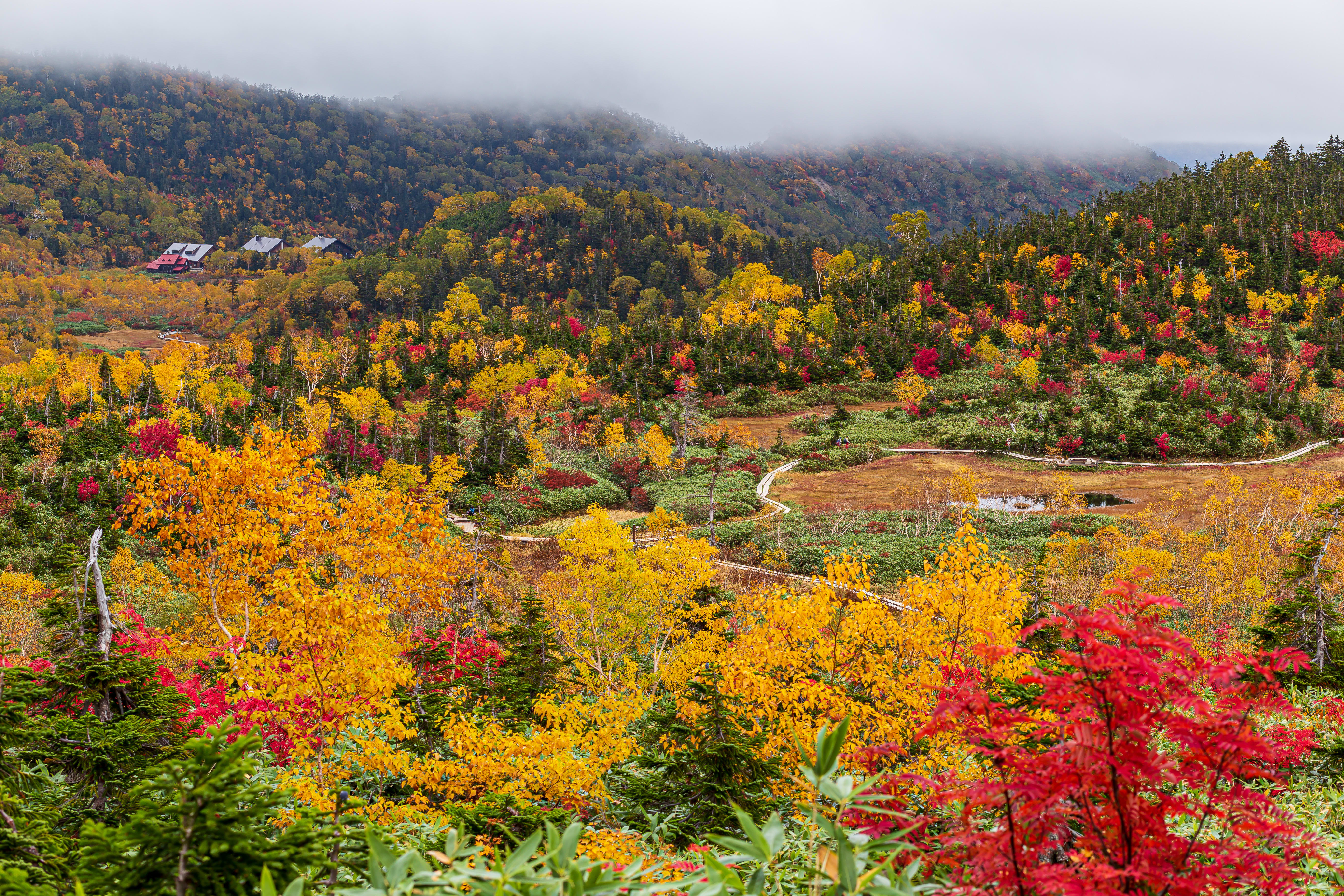
Tsugaike Nature Park's network of boardwalks, Chubusangaku National Park
Japan’s northernmost ropeway (excluding chair lifts) is in Daisetsuzan National Park in Hokkaido. The Daisetsuzan Sounkyo Kurodake Ropeway connects you to the Fifth Station on Mount Kurodake, offering sweeping views of the Sounkyo Gorge. In autumn, you’ll have the chance to see Japanese rowan covering the slopes above the tree line in this area. The foliage season generally lasts from late September to early October in Hokkaido’s national parks.
Several ropeways in the Northern Japanese Alps are extremely popular in autumn. The Shinhotaka Ropeway in Chubusangaku National Park offers visitors extraordinary alpine views with access to warm footbaths, hot springs, and a short nature trail. In the park's Hakuba area, numerous ski resorts operate their ropeways and chairlifts during the fall season for leaf viewing, including a ropeway that provides access to Tsugaike Nature Park where you can walk along elevated wooden promenades amid vibrant foliage.
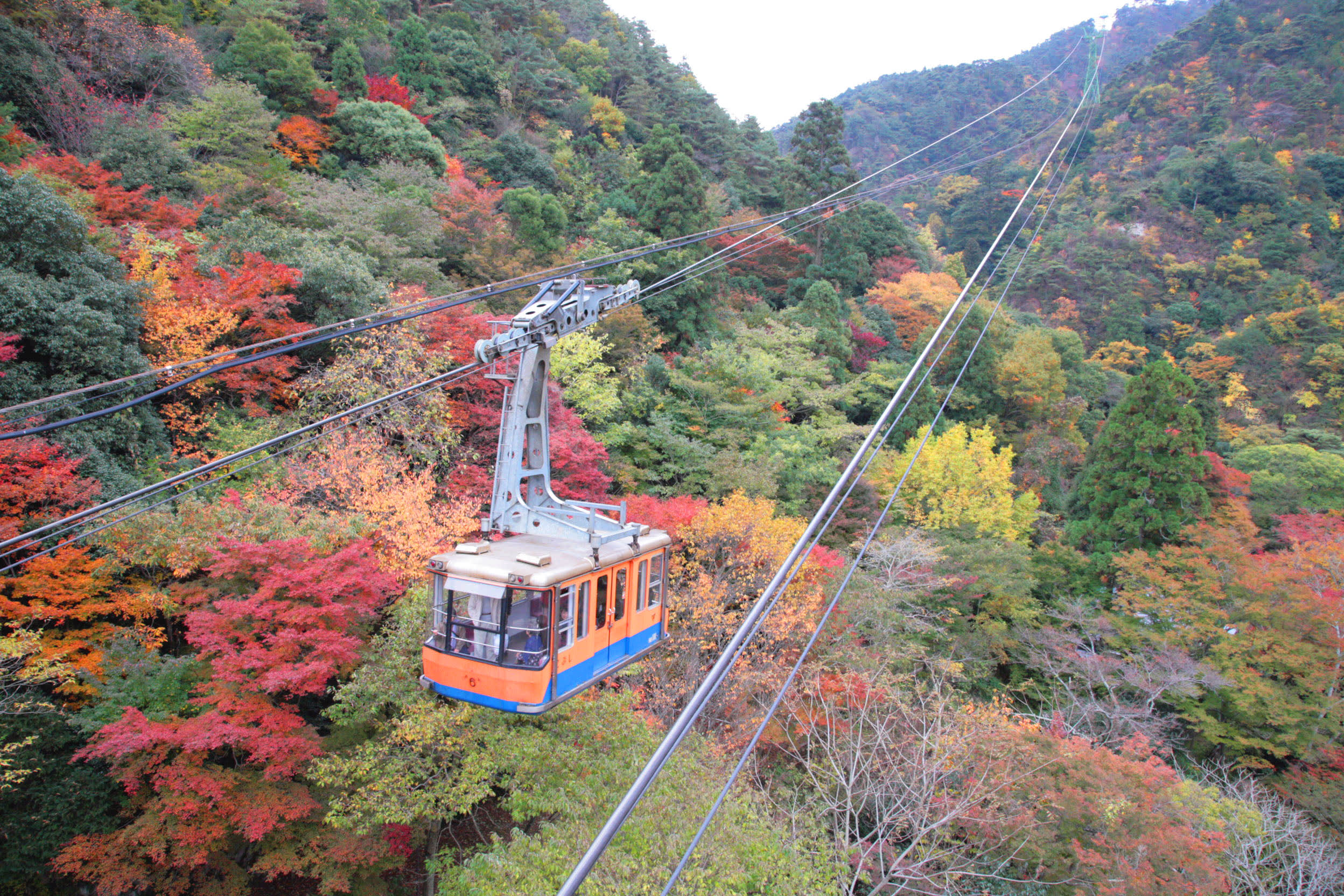
A ropeway whisks visitors up Mount Rokko in Setonaikai National Park
Further south, nature lovers can explore Mount Yoshino in Yoshino-Kumano National Park or access Mount Rokko in Setonaikai National Park via ropeways and cable cars. Both areas are prime spots for viewing autumn colors.
Explore colorful landscapes by car
Driving along a scenic highway through the mountains is one way to enjoy the picturesque fall scenery at your own pace. Many of the remote mountain roads in Japan’s national parks were specifically designed for sightseeing and provide convenient access to short walking trails, observatories, hot springs and secluded waterfalls.
The Bandai-Azuma Skyline passes through the high elevations of the Azuma mountain range in Bandai-Asahi National and is one of Japan’s most thrilling scenic drives. In autumn, the area’s volcanic scenery is highlighted with pockets of color from the mountainside's changing foliage.
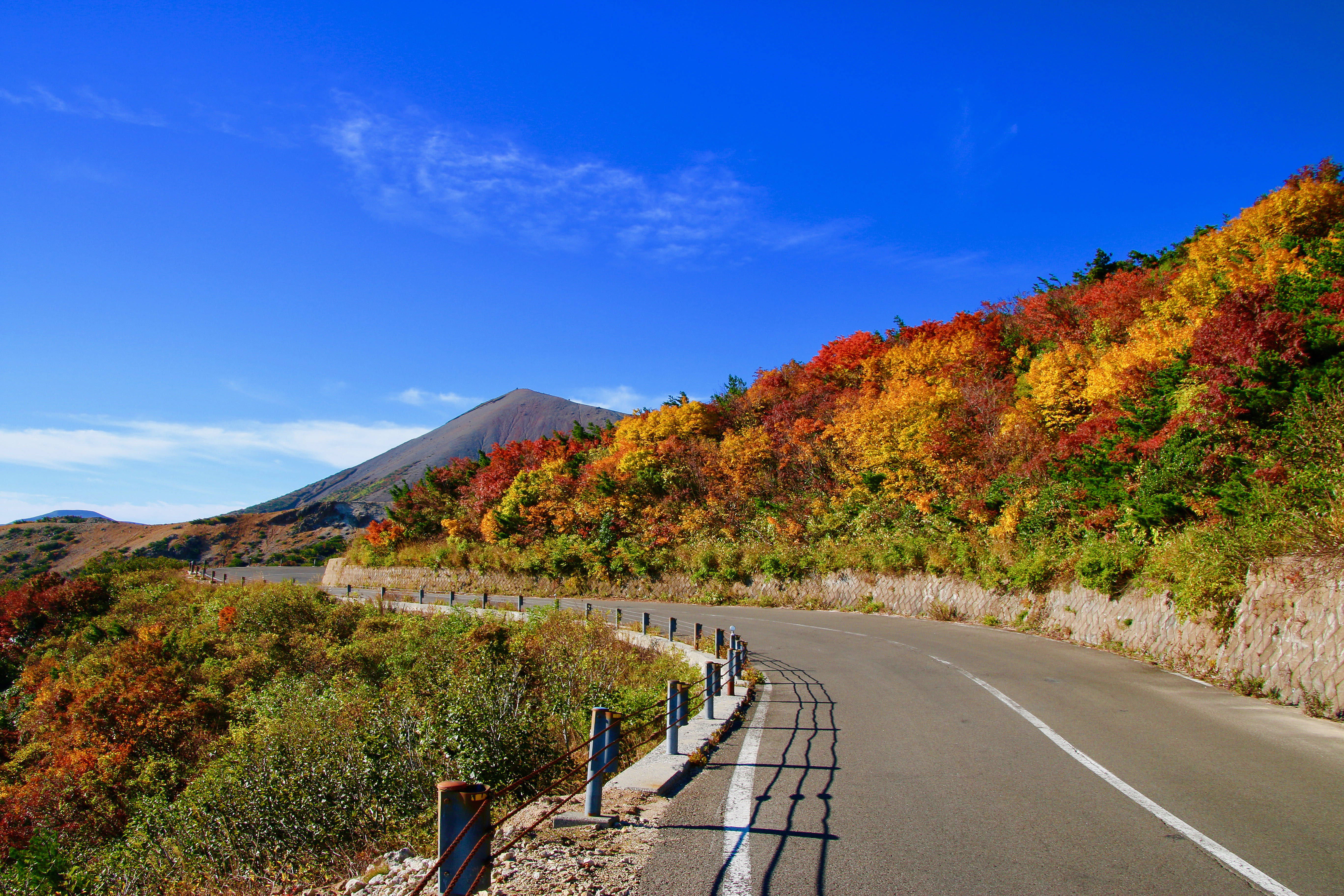
The Bandai-Azuma Skyline in Bandai-Asahi National Park offers spectacular views
Enjoy outstanding panoramic views along the Hakusan Shirakawa-go White Road in Hakusan National Park when the surrounding trees change glorious red, orange, yellow hues. The road passes three of Mount Hakusan’s peaks, hot springs, and a series of waterfalls.
The scenic byways of Daisen-Oki National Park are noted for their beauty and have plenty of lookouts and rest areas where you can stop to view the autumn foliage. Take a drive along the Hiruzen-Daisen Skyline and the Daisen Parkway for unparalleled autumn scenery and views of majestic Mount Daisen.
Beaches without the crowds
Japan’s subtropical islands are generally hot and humid during summer, but temperatures become more comfortable towards the end of October and November, hovering between 20 and 25 degrees Celsius. Autumn can be an excellent time to enjoy the beaches and coastlines of Japan’s southern national parks without the throngs of tourists.
Beach season in Okinawa is officially open until the end of October, although some remote beaches may stay open throughout the year. September is peak typhoon season in Okinawa, when flight cancellations are common and humidity is high. Typhoons generally taper off in October and the weather becomes stable in November, with mostly clear skies.

Aharen Beach in Keramashoto National Park at sunset
Keramashoto National Park’s accessibility makes it a great destination for autumn beachcombing. You can go island hopping and enjoy the many pristine beaches within the park, including the beaches of Zamamijima and Akajima as well as the beaches of Tokashikijima. Take a drive or hike up to one of the park’s many observatories for stunning coastal views.
From nature hikes and scenic drives to ropeway rides and island hopping, the parks offer endless opportunities to enjoy the mild-weather days and beautiful colors of autumn.
Written by Erin Kessler


























